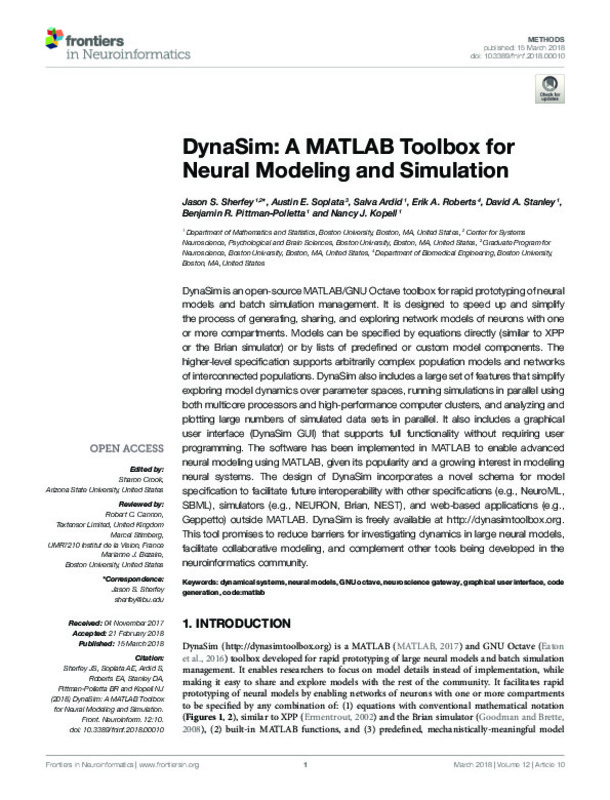Bokil, H., Andrews, P., Kulkarni, J. E., Mehta, S., & Mitra, P. P. (2010). Chronux: A platform for analyzing neural signals. Journal of Neuroscience Methods, 192(1), 146-151. doi:10.1016/j.jneumeth.2010.06.020
Brette, R., Rudolph, M., Carnevale, T., Hines, M., Beeman, D., Bower, J. M., … Destexhe, A. (2007). Simulation of networks of spiking neurons: A review of tools and strategies. Journal of Computational Neuroscience, 23(3), 349-398. doi:10.1007/s10827-007-0038-6
Börgers, C., & Kopell, N. (2005). Effects of Noisy Drive on Rhythms in Networks of Excitatory and Inhibitory Neurons. Neural Computation, 17(3), 557-608. doi:10.1162/0899766053019908
[+]
Bokil, H., Andrews, P., Kulkarni, J. E., Mehta, S., & Mitra, P. P. (2010). Chronux: A platform for analyzing neural signals. Journal of Neuroscience Methods, 192(1), 146-151. doi:10.1016/j.jneumeth.2010.06.020
Brette, R., Rudolph, M., Carnevale, T., Hines, M., Beeman, D., Bower, J. M., … Destexhe, A. (2007). Simulation of networks of spiking neurons: A review of tools and strategies. Journal of Computational Neuroscience, 23(3), 349-398. doi:10.1007/s10827-007-0038-6
Börgers, C., & Kopell, N. (2005). Effects of Noisy Drive on Rhythms in Networks of Excitatory and Inhibitory Neurons. Neural Computation, 17(3), 557-608. doi:10.1162/0899766053019908
Ching, S., Cimenser, A., Purdon, P. L., Brown, E. N., & Kopell, N. J. (2010). Thalamocortical model for a propofol-induced -rhythm associated with loss of consciousness. Proceedings of the National Academy of Sciences, 107(52), 22665-22670. doi:10.1073/pnas.1017069108
Delorme, A., & Makeig, S. (2004). EEGLAB: an open source toolbox for analysis of single-trial EEG dynamics including independent component analysis. Journal of Neuroscience Methods, 134(1), 9-21. doi:10.1016/j.jneumeth.2003.10.009
Durstewitz, D., Seamans, J. K., & Sejnowski, T. J. (2000). Neurocomputational models of working memory. Nature Neuroscience, 3(S11), 1184-1191. doi:10.1038/81460
EatonJ. W. BatemanD. HaubergS. WehbringR. GNU Octave Version 4.2.0 Manual: A High-Level Interactive Language for Numerical Computations2016
Ermentrout, B. (2002). Simulating, Analyzing, and Animating Dynamical Systems. doi:10.1137/1.9780898718195
FitzHugh, R. (1955). Mathematical models of threshold phenomena in the nerve membrane. The Bulletin of Mathematical Biophysics, 17(4), 257-278. doi:10.1007/bf02477753
Gewaltig, M.-O., & Diesmann, M. (2007). NEST (NEural Simulation Tool). Scholarpedia, 2(4), 1430. doi:10.4249/scholarpedia.1430
Gleeson, P., Crook, S., Cannon, R. C., Hines, M. L., Billings, G. O., Farinella, M., … Silver, R. A. (2010). NeuroML: A Language for Describing Data Driven Models of Neurons and Networks with a High Degree of Biological Detail. PLoS Computational Biology, 6(6), e1000815. doi:10.1371/journal.pcbi.1000815
Goodman, D. (2008). Brian: a simulator for spiking neural networks in Python. Frontiers in Neuroinformatics, 2. doi:10.3389/neuro.11.005.2008
Goodman, D. F. M. (2009). The Brian simulator. Frontiers in Neuroscience, 3(2), 192-197. doi:10.3389/neuro.01.026.2009
Hines, M. L., & Carnevale, N. T. (1997). The NEURON Simulation Environment. Neural Computation, 9(6), 1179-1209. doi:10.1162/neco.1997.9.6.1179
Hodgkin, A. L., & Huxley, A. F. (1952). A quantitative description of membrane current and its application to conduction and excitation in nerve. The Journal of Physiology, 117(4), 500-544. doi:10.1113/jphysiol.1952.sp004764
Hucka, M., Finney, A., Sauro, H. M., Bolouri, H., Doyle, J. C., Kitano, H., … Wang. (2003). The systems biology markup language (SBML): a medium for representation and exchange of biochemical network models. Bioinformatics, 19(4), 524-531. doi:10.1093/bioinformatics/btg015
Izhikevich, E. M. (2003). Simple model of spiking neurons. IEEE Transactions on Neural Networks, 14(6), 1569-1572. doi:10.1109/tnn.2003.820440
Kopell, N., Ermentrout, G. B., Whittington, M. A., & Traub, R. D. (2000). Gamma rhythms and beta rhythms have different synchronization properties. Proceedings of the National Academy of Sciences, 97(4), 1867-1872. doi:10.1073/pnas.97.4.1867
Kramer, M. A., Roopun, A. K., Carracedo, L. M., Traub, R. D., Whittington, M. A., & Kopell, N. J. (2008). Rhythm Generation through Period Concatenation in Rat Somatosensory Cortex. PLoS Computational Biology, 4(9), e1000169. doi:10.1371/journal.pcbi.1000169
Lorenz, E. N. (1963). Deterministic Nonperiodic Flow. Journal of the Atmospheric Sciences, 20(2), 130-141. doi:10.1175/1520-0469(1963)020<0130:dnf>2.0.co;2
Markram, H., Meier, K., Lippert, T., Grillner, S., Frackowiak, R., Dehaene, S., … Saria, A. (2011). Introducing the Human Brain Project. Procedia Computer Science, 7, 39-42. doi:10.1016/j.procs.2011.12.015
McDougal, R. A., Morse, T. M., Carnevale, T., Marenco, L., Wang, R., Migliore, M., … Hines, M. L. (2016). Twenty years of ModelDB and beyond: building essential modeling tools for the future of neuroscience. Journal of Computational Neuroscience, 42(1), 1-10. doi:10.1007/s10827-016-0623-7
Meng, L., Kramer, M. A., Middleton, S. J., Whittington, M. A., & Eden, U. T. (2014). A Unified Approach to Linking Experimental, Statistical and Computational Analysis of Spike Train Data. PLoS ONE, 9(1), e85269. doi:10.1371/journal.pone.0085269
Morris, C., & Lecar, H. (1981). Voltage oscillations in the barnacle giant muscle fiber. Biophysical Journal, 35(1), 193-213. doi:10.1016/s0006-3495(81)84782-0
Rudolph, M., & Destexhe, A. (2007). How much can we trust neural simulation strategies? Neurocomputing, 70(10-12), 1966-1969. doi:10.1016/j.neucom.2006.10.138
Stimberg, M., Goodman, D. F. M., Benichoux, V., & Brette, R. (2014). Equation-oriented specification of neural models for simulations. Frontiers in Neuroinformatics, 8. doi:10.3389/fninf.2014.00006
Traub, R. D., Buhl, E. H., Gloveli, T., & Whittington, M. A. (2003). Fast Rhythmic Bursting Can Be Induced in Layer 2/3 Cortical Neurons by Enhancing Persistent Na+Conductance or by Blocking BK Channels. Journal of Neurophysiology, 89(2), 909-921. doi:10.1152/jn.00573.2002
[-]









